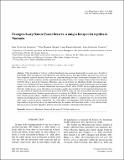| dc.description.abstract | While knowledge of African vertebrate biodiversity has increased dramatically in recent years, the field of herpetology which encompasses many threatened and endemic species, has lagged behind, and many areas have not been adequately explored. Intensive field work was conducted during the rainy season from December 2017 to April 2018 to assess reptile occurrence mostly in previously unexplored areas of the Uzungwa Scarp Nature Forest Reserve (USNFR) which is part of the Udzungwa Mountain ranges in the Eastern Arc Mountains (EAM), and adjacent agricultural areas. Bucket pitfall traps, funnel traps, night transects and opportunistic search methods were used to sample reptiles across four zones: in lowland, submontane and montane forests of the USNFR, and in neighboring farmlands. Forty-five reptile species across 14 families were recorded, mostly concentrated on the lowland and submontane forests. The number of endemic and threatened species in the USNFR reaches 20 and 14 respectively, and most are found in the submontane forest. Nineteen species were new records for the USNFR, five of them representing range extensions. Reptile species richness, abundance and diversity differed significantly across the four zones, except between montane and farmland zones and between lowland and submontane. However, farmland zone was discordant from other zones in terms of species composition. This study adds to the importance of the EAM not only in harbouring large numbers of species but also as an important hotspot for endemic and threatened reptiles. It also calls for proper land-use practices in farms adjacent to protected areas for sustainable conservation of biodiversity. | en_US |

